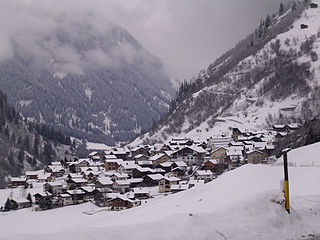
Hundwil is a municipality in the canton of Appenzell Ausserrhoden in Switzerland.

Teufen is a municipality in the canton of Appenzell Ausserrhoden in Switzerland.

Trogen is a municipality in the canton of Appenzell Ausserrhoden in Switzerland. The town is the seat of the canton's judicial authorities.

Heiden is a village and a municipality in the canton of Appenzell Ausserrhoden in Switzerland. Its Biedermeier village around the church square is listed as a heritage site of national significance.

Lutzenberg is a municipality in the canton of Appenzell Ausserrhoden in Switzerland. Its hamlet of Tobel is listed as a heritage site of national significance.

Walzenhausen is a municipality in the canton of Appenzell Ausserrhoden in Switzerland.

Reute is a municipality in the canton of Appenzell Ausserrhoden in Switzerland.

Rorschach is a municipality, in the District of Rorschach in the canton of St. Gallen in Switzerland. It is on the south side of Lake Constance (Bodensee).

Birr is a municipality in the Swiss canton of Aargau and the capital of Brugg (district). The village lies halfway between Lenzburg and Brugg. Birr has grown with its neighbour Lupfig into a conurbation.

Valeyres-sous-Ursins is a municipality in the district of Jura-Nord Vaudois of the canton of Vaud in Switzerland.

Villars-Epeney is a municipality in the district of Jura-Nord Vaudois of the canton of Vaud in Switzerland.
Mutrux is a municipality in the district of Jura-Nord Vaudois in the canton of Vaud in Switzerland.

Ftan is a former municipality in the district of Inn in the Swiss canton of Graubünden. On 1 January 2015 the former municipalities of Ardez, Guarda, Tarasp, Ftan and Sent merged into the municipality of Scuol.

Remetschwil is a municipality in the district of Baden in the canton of Aargau in Switzerland.

Turgi is a former municipality in the district of Baden in the canton of Aargau in Switzerland, located in the Limmat Valley. It merged with Baden on 1 January 2024.

Gams is a municipality in the Wahlkreis (constituency) of Werdenberg in the canton of St. Gallen in Switzerland.

Alt St. Johann is a village in the Toggenburg region, since 2010 part of the municipality Wildhaus-Alt St.Johann in the canton of St. Gallen in Switzerland.

Conters im Prättigau is a Swiss village in the Prättigau and a municipality in the political district of Prättigau/Davos Region in the canton of Graubünden.

Medel is a municipality in the Surselva Region in the Swiss canton of Graubünden.
Gregor Gustav Adolf Tobler (1834–1875) was a Swiss merchant, artist, and naturalist. He immigrated to the Philippines and lived in Majayjay, Laguna, for over a decade. He adopted the Hispanic name Don Gustavo Tobler, married a local mestiza woman, published a humorous travel book, and owned a flourishing vast coffee plantation from 1862 until his death in 1875.























